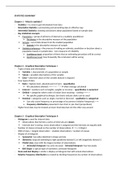Samenvatting
Samenvatting theorie Statistiek | premaster RSM
- Instelling
- Erasmus Universiteit Rotterdam (EUR)
Dit document bevat een samenvatting van Hoofdstuk 1 t/m 4 en 6 t/m 12 uit het boek Managerial Statistics van Keller (2014). De samenvatting bevat alle theorie die je moet weten voor het tentamen van Statistiek. Statistiek is onderdeel van de premaster, RSM Erasmus Universiteit. De samenvatting is i...
[Meer zien]





